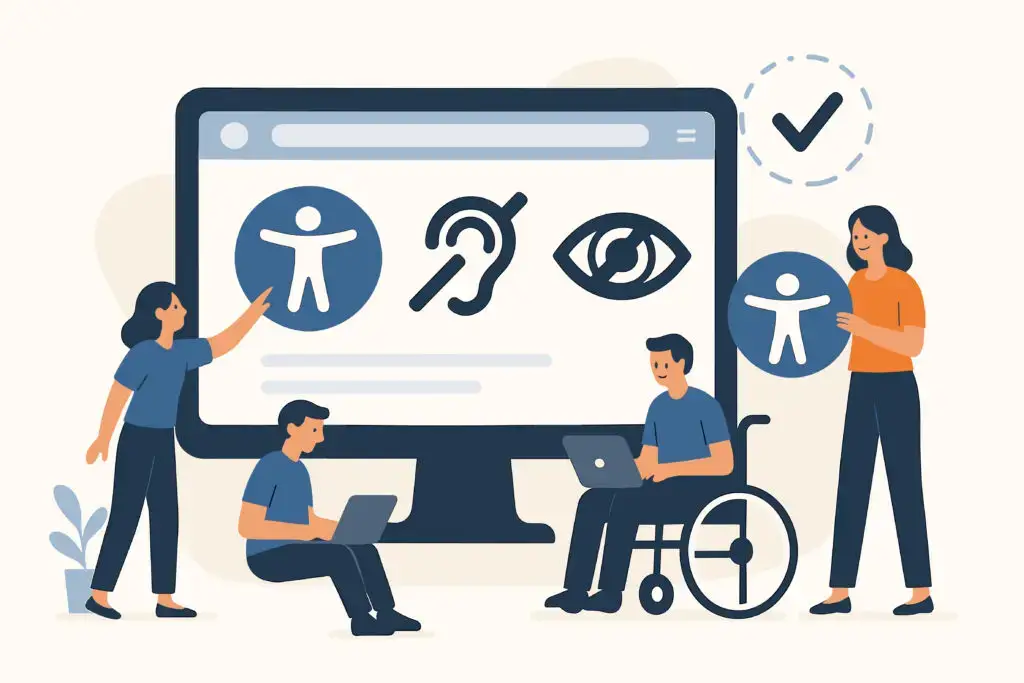A great website should work for everyone. It’s as simple as that.
Your website is often the first thing users visit when finding your business online. And so, as the hub of your online presence and where you can effectively reflect your brand values, you need to ensure it delivers an experience that’s inclusive to all.
Accessibility ensures that no matter a person’s ability, device, or circumstances, they can interact with your content, products, and services without barriers.
Being an inclusive and accessible business in 2025 is no longer a choice, it’s an expectation. It sends a clear message that your brand respects and welcomes all abilities and disabilities.
But in addition to that, it can also have an impact on how your website performs in search results. Features such as descriptive alt text, logical headings, responsive design, and fast-loading content are essential for accessibility and also align closely with SEO best practices.
In this article, we will explore why accessibility matters, the risks of ignoring it, and the practical steps you can take to make your website a place where everyone feels at home.
What is web accessibility?
Web accessibility is about designing and developing websites, tools and other technologies that are easy for anyone to understand, navigate and interact with.
This includes individuals with visual, hearing, motor, or cognitive impairments, as well as people using different devices and technologies.
Adjustments you can make to your website can include:
- Creating transcripts for videos and audio
- Having an option for colour contrast or grayscaling for those with colour blindness
- Adding alt text to images for people with blindness or poor eyesight
- Enlarging text or editing to a more readable font
Why is website accessibility important?
Over 1.3 billion people worldwide live with some form of disability. That’s almost 16% of the global population. On top of that, between 70-80% of disabilities are hidden – this includes visual impairments, hearing loss, neurodivergent traits and some forms of autism.
If your website isn’t accessible, you’re shutting out this huge market.
Everyone deserves the same opportunity to access information, buy products, or use services online. By removing barriers, you make your website a welcoming space for all users.
Equal access and inclusivity
The internet has become central to daily life, from shopping and banking to learning and communicating. When a website is inaccessible, it can exclude individuals from these essential activities and create unnecessary barriers.
Equal access means that a person using a screen reader has the same opportunity to navigate your website as someone using a mouse. It means that a customer with colour blindness can understand your product information, and someone with hearing loss can still enjoy your video content with captions.
By designing with inclusivity in mind, you are creating an online space where no one is disadvantaged or left behind.
Understanding WCAG
The Web Content Accessibility Guidelines (WCAG) provide the internationally recognised standards for making websites accessible. They are built around four key principles:
Perceivable
Information and content must be presented in ways that users can recognise and understand, such as providing text alternatives for images.
Operable
Navigation and interactive elements must be usable for everyone, including people who rely on keyboards or assistive technologies.
Understandable
Content and interfaces should be clear, consistent, and easy to follow
Robust
Websites must be designed to work with a wide range of current and future technologies, including screen readers and other assistive tools.
Following WCAG helps ensure your website is inclusive, legally compliant, and future-proof.
How website accessibility impacts Search Engine Optimisation
Accessibility and SEO go hand in hand. Many of the best practices that make a website accessible also improve how search engines understand and rank your content. In other words, by designing your site to be more inclusive, you are also making it more visible.
Alt text for images
Adding descriptive alternative text on all images on your website means screen readers can describe images to users with visual impairments. The same descriptions also help search engines understand what your images represent, improving your chances of appearing in image search results.
Clear headings and structure
Logical use of headings (H1, H2, H3) helps people using assistive technologies navigate your content. Search engines use these same headings to understand the hierarchy and relevance of your information.
Video captions and transcripts
Captions make video content accessible for users with hearing impairments. Transcripts not only improve accessibility but also provide keyword-rich content that search engines can index.
What do QBD say about website accessibility?
Accessibility can be an intimidating part of building a website. Knowing how important it is and wanting to get it right can leave many businesses feeling a little overwhelmed.
The web is where people go to learn, shop, connect, and carry out everyday tasks, and excluding users through poor design is both unfair and avoidable. Accessibility ensures that everyone, regardless of ability, has the same opportunity to interact with your business online. Accessible websites are easier to navigate, perform better in search engines, and deliver a smoother experience for all users. In 2025, accessibility should not be seen as an extra feature but as a standard that every business commits to if they want to be relevant, competitive, and trusted.
Gary White, Head of Technical Web Design
At QBD all of our websites are designed and built with accessibility in mind. When we’re helping brands launch their online presence, we know it’s vital for everyone, and every ability to be able to interact and learn about their products or services.
To learn more about making your website accessible and user-friendly to all, get in touch today.
About the authors

Molly Sneath
Molly is our PPC & Digital Marketing Specialist.
As well as managing QBD’s marketing activities, she supports multiple clients and projects with her skills in SEO, social media management and Pay-per-click, specifically Google Ads. She also has strong copywriting skills and writes blogs for clients who have a monthly subscription with us.

